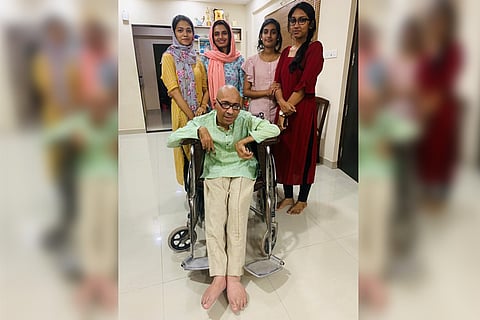

Our actions can touch hearts when we put thought into them. The third-year fashion designing students of Ernakulam’s St Teresa’s College experienced this magic when they experimented with the concept of adaptive clothing as part of their ‘Design Thinking Project’.
A group of 28 students designed and stitched garments and accessories for three persons with disabilities – Paresh C Palicha, Aisha Bivi and Devi Sreedharan – drawing inspiration from the global adaptive clothing trend. Of the three, two are wheelchair users and one is bedridden.
“Earlier, we were asked to participate in a national level competition for adaptive clothing. However, we could not make it due to certain reasons. I was fascinated by the idea and so decided to give it a shot this time,” says Lekha Sreenivas, Associate Professor, Department of Fashion Designing and Centre Coordinator, Women’s Study Centre, who guided the students in the endeavour.
The project on adaptive clothing was also the first time they took the project out of the campus. “In the previous years, students identified possibilities within the department,” adds Lekha. Walk into the department and one can witness these in the form of Warli and Mandala designs painted on the walls, and an easy-to-manage name card rack hanging outside the staff room.
Understanding adaptive clothing
The first step before they embarked on the project was to understand the various dimensions of adaptive clothing, an initiative for the elderly and for people with disabilities.
Wheelchair with cushion
“We first heard about it during Lekha ma’am’s class at the beginning of the fifth semester. We had little knowledge about it. A vague idea formed in our mind after listening to the lectures and watching a few videos related to it,” says Amritha on behalf of her classmates, as Farhana, Aswathy, Farsha and others present in the classroom join the conversation.
The five steps
The project was then divided into five steps: empathise, define, ideate, prototype and test fit. “The first two steps involved meeting our subjects, and brainstorming sessions to define the task,” say students.
Paresh, who is a freelance writer and a full-time employee in the private sector, was their mentor. He visited them on campus to share his views on the concept. “He shared with us his interests and the issues faced while dressing,” says Farsha. It was also a matter of learning from observation for the students.
Paresh in party wear outfit
“Some issues they told us; some we figured out from our interactions. For instance, Paresh sir had not mentioned back pain, but we felt adding a cushion to his wheelchair would help him. For the women, we made a fabric belt that can be used to secure what they are wearing over their shoulder while in the toilet. The clothes can sometimes fall, causing them to trip,” she adds.
“The fact is, in many cases people don’t realise that these are problems. Solutions like fabric belt can also help those who take care of the elderly,” explains Lekha.
The third phase saw them zeroing in on designs for Paresh, Aisha and Devi. Each group designed two clothes for Paresh and one each for the women. “We made two party wear outfits and two casual wear outfits for Paresh sir, and night dresses for the women,” says Aswathy. “Paresh sir had told us that he loves attractive shades, green being his favourite. And he wanted full sleeves. We adhered to that and prepared easy-to-wear outfits in green, beige and blue.”
Medicine pouch attached to wheelchair
In the fourth phase, they created prototypes. For Paresh, they made kurtas with press buttons that can be opened fully, and trousers secured with a zip on the sides. For Aisha and Devi, they created nighties with belts.
For the fifth stage – the test fitting – they went to everyone’s house.
Paresh is happy about the outcome of the project. “Earlier, I would take about 15 minutes to wear my trousers. Now, it has become easier. The salwar the students designed took just two minutes,” he says.
Paresh is not new to adaptive clothing. He had associated with Ekansh Trust, Pune, before. He had a great time interacting with the St Teresa’s students on the campus. “We met at the college ground. Once we reached a comfort zone, we talked and shared our thoughts.”
Bib for senior citizens
Besides the outfits and a cushion for his wheelchair, the students also designed a laptop bag that can be attached to his wheelchair. “Because he goes out for work,” says Farsha. “Aisha and Devi stay at home, so, for them we created items like medicine pouches, bibs and cushions.”
Design aspect
When you hear ‘easy to wear’, ‘front and back open’, don’t think these clothes are clumsily done. “You won’t see those zippers and cuts. They are aesthetically covered with design. For example, the bib designed for Paresh looks like a jacket,” says Lekha.
Everything, except the difficult items like the cushion and the laptop bag, were stitched by the students. All the items were also designed by the students. They used natural, breathable fabric for the venture.
In a way, it was a challenge for them. “We were worried whether the measurements would be correct and whether they would like it,” they say.
It was a learning experience, too. “We tried to put ourselves in their shoes and recognise their problems,” they say. “And, we learnt from our shortcomings. We understood the areas where we can improve. It was a give and take process,” recalls Lekha, who wishes to take the idea forward.
The idea has already started to receive good feedback from outside the campus. The department plans to do the project on a larger scale in the coming years. There might even be a ramp walk!
Elizabeth Thomas describes herself as a wild woman who finds happiness in words, colours, coffee and journeys.